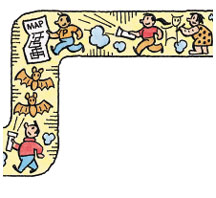To read our exclusively online On the Campus column, click here.
February 9, 2005: On the Campus
Illustration by Ron Barrett |
Exploring worldviews ... and tunnels
By Katherine Reilly ’05
On Christmas Eve, members of the Princeton Debate Panel boarded a plane at JFK International Airport, beginning a 28-hour journey to Malaysia. The students were headed to Asia to represent Princeton, home of America’s oldest and most successful college debate team, at the World University Debating Championships.
The undergraduates got word of the tsunami that devastated the region while awaiting the final leg of their flight. Cyberjaya, where the tournament host Multimedia University is located, was unaffected. Dan Greco ’06, the panel’s president, reported that the six Princeton students followed the story as it unfolded in the Malaysian press, but didn’t feel any “tangible effects on the ground.” By the time the tournament was declared open on Dec. 28, nearly 1,000 competitors had arrived from 35 countries to spend a week debating the issues of the day.
Squaring off in teams of two, the students competed in nine rounds of parliamentary debate. Notified of the topics of their contests minutes before each round, Princeton’s debaters argued knowledgeably on subjects from outsourcing to organ donation to North Africa’s involvement in the EU. Andrew Bruck ’05 said his competitors were “all incredibly intelligent people. It actually is fun to debate people who all have a different perspective. You’re debating your worldview.”
Alice Zhou ’07, a judge at the tournament, used her time in Malaysia to meet debaters from other countries and to enjoy the social events hosted at venues in Kuala Lumpur, the capital city.
Princeton did not qualify for elimination rounds at the competition, which was won by a team of Canadian law students. The Malaysian education minister opened the final round of competition by inviting students to return to Malaysia when they became leaders of their nations. Despite the welcome from the government, participants knew that free exchange of ideas was not always so common in Malaysia. “It’s so weird to be in a country having a debate tournament where debating the policies of the country could land you in prison,” Bruck said.
Princeton students also have gone exploring closer to home. Taking their cues from the best-selling The Rule of Four, in which the main characters engage in a chase through the network of tunnels beneath Princeton’s campus, undergraduates have revived the tradition of steam-tunneling.
In her opening address to the Class of 2008 last fall, President Tilghman told the incoming freshmen, “You can just forget about looking for the steam tunnels — they don’t exist!” The undergraduates who have pried open grates and lifted up manhole covers to descend beneath Princeton, however, have proved President Tilghman wrong, finding tunnels that traverse the University.
One senior in the Woodrow Wilson School, who joined three friends in the tunnels for the first time over winter break, reported finding an entrance behind Dillon Gymnasium. “You always want to go at night because where you get in is really visible,” he said.
This particular entrance led to an eight-foot drop that took the students to a long hallway, from which narrower tunnels branched off in all directions. Armed with a spelunking flashlight, the group explored the area under the southern part of campus, finding hot, tight tunnels and wide-open rooms filled with abandoned appliances and old filing cabinets.
Exploring the tunnels is a violation of University policy, but some feel that it’s a risk worth taking. “I’m a senior, so I couldn’t pass up the chance to partake in a grand Princeton secret and add to my fond college memories,” said one English major.
Another student, an anthropology major, cited the need for “exciting, quasi-clandestine campus events” as a reason for the revived popularity of the tunnels. Donald Reichling, acting head of support services for Public Safety, said he did not remember anyone being caught in the tunnels for several years.
Harvard and MIT also have a maze of underground steam tunnels explored
by adventurous students, but Princeton’s are the only ones to be
immortalized in a best-selling novel. Though Public Safety and the University
administration may hope that steam-tunneling is one tradition that doesn’t
last, some students are determined to have their own underground adventures.
As one senior noted, “It seems as though the tunnels are something
I should see for myself.” ![]()
Katherine Reilly ’05, a Woodrow Wilson School major, is from Short Hills, N.J. She is novice education co-director and former president of the Princeton Debate Panel.
ON THE CAMPUS ONLINE: Click here to read “Snapshots from the first semester,” by P.G. Sittenfeld ’07.


